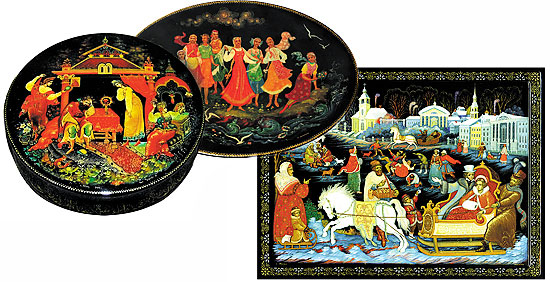PALEKH LACQUER MINIATURES
Palekh miniatures are a folk handicraft which developed in the village of Palekh in Ivanovo province.
The first mention of Palekh is found at the beginning of the 17th century. Historians are unable to find a date recorded in documents for the foundation of Palekh, but it is thought that the settlement existed before the 15th century and arose as a refuge for Finno-Ugric tribes which inhabited Ivanovo province in large numbers.
In various documents of those times there is talk of developed icon painting in Palekh, whose fame by the mid-17th century reached Moscow, where local masters started being invited to paint. Palekh icon painting underwent its greatest flourishing in the 18th and early 19th centuries. The local style formed under the influence of the Moscow, Novgorod, Stroganov and Yaroslavl schools.
As strange as it may sound, Palekh’s residents owe the birth of their unique icon painting to the Tatar-Mongol invasion. Because of the Tatars’ attacks, the artists of Vladimir and Suzdal left their homes and were forced to resettle in safe regions. Thus icon painting appeared in Palekh; this art was very much in demand in the 16th and 17th centuries. Monastery artists were unable to meet the demand for icons which decorated not only churches and homes, but which were also carried on one’s person as miniature images of the saints. No better prerequisites for the development of this craft in Palekh could have been found. At first Palekh artists simply copied the style of other cities, but after some time they developed their own unique manner of painting icons.
After the October Revolution of 1917, the icon painters of Palekh were forced to search for new ways to apply their creativity. They mastered new material, transferring to it the technique, traditional for the old Russian icon, of tempura painting and conditioned depiction styles. The art of drawing images and icons with subtlety was successfully transferred by the Palekh masters over to small wooden boxes (shkatulki), creating their own artistic style. Lacquer miniatures – in addition to wooden boxes (shkatulki and lartsy) – were used for various articles: broaches, panels, powder cases, tie tacks, needle cases and so on. Part and parcel of the new art was a new set of themes: subjects from everyday village life, literary classics, fairytales, epics (byliny) and songs were added. Thus arose a new style of miniature painting based on the principles of painting in old Rus and folk art, unique in the subtleties of its artistic techniques. The precious miniatures of Palekh masters triumphantly underwent exhibitions in Europe, America and Asia, receiving the grand prix at the World Expo in Paris.
The distinguishing traits of the Palekh school are the miniature (minute) multiply-marked painting, the overall soft tone of the painting, the diversity of composition elements and their picturesque appearance, the patterned nature of the painting, the diversity of rainbow reflections, trees with natural leaves, the elongation of the figures, the subtlety of the fusion of the heads and exposed parts of the figures, and the multitone backgrounds (even golden ones).
The process by which Palekh miniatures are born is long and complicated. Artists use a special material, papier-mache, covered by black putty, on which a bleaching underpainting is applied. The lacquer miniature is made using tempera. Works are usually made on a black background and painted with gold. The artist’s work demands extreme precision and accuracy. Often Palekh artists must use a magnifying glass in their work.
Palekh lacquer miniatures are not only famous all over the world, but have gained a special stature and become a symbol of Russia – they are an integral part of Russian decorative and applied art.

